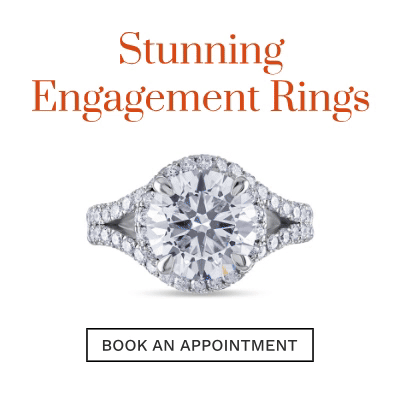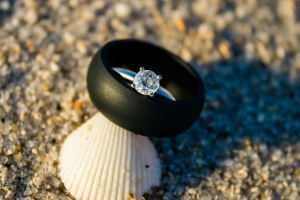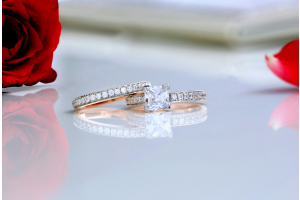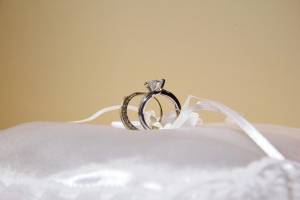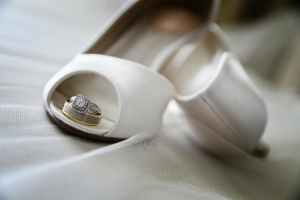GBP
/
GBP
/
Shipping to:
Currency:
A Beginner’s Guide to Diamond Clarity and What It Means for Engagement Rings
When you're shopping for an engagement ring, one term you’ll come across frequently is "diamond clarity." But what does it actually mean? And how important is it when choosing the perfect diamond? This guide will walk you through everything you need to know about diamond clarity and how it affects the beauty, value, and overall appeal of your engagement ring.
Understanding the Importance of Diamond Clarity
Diamond clarity refers to how flawless a diamond is both inside and out. No diamond is completely perfect under magnification, but those with fewer imperfections are considered higher in clarity.
So, why should you care about clarity when shopping for a ring? Well, a diamond’s clarity affects its overall appearance, sparkle, and price. Some flaws are so small that they can only be seen under a microscope, while others might be visible to the naked eye.
For most people, the goal is to find a diamond that strikes a balance between beauty and budget. And that’s where understanding diamond clarity can make a huge difference. To explore a wide range of engagement rings, check out our stunning collection.
What Is Diamond Clarity?
In simple terms, diamond clarity measures the presence (or absence) of internal flaws, known as inclusions, and surface imperfections, known as blemishes. The fewer inclusions or blemishes a diamond has, the higher its clarity grade.
These imperfections occur naturally as diamonds form deep within the Earth under immense pressure, making every diamond unique.
Inclusions are like nature’s fingerprint on a diamond, and unless you're going for a flawless stone (which comes with a hefty price tag), most diamonds will have some imperfections. However, many of these are invisible to the naked eye and won’t affect the stone’s brilliance or durability.
The Diamond Clarity Grading Scale
To make it easier for shoppers, the Gemological Institute of America (GIA) developed a clarity grading scale. Here’s a quick breakdown:
- Flawless (FL): No inclusions or blemishes visible under 10x magnification. Extremely rare and expensive.
- Internally Flawless (IF): No internal inclusions, only minor surface blemishes. Still very rare.
- Very, Very Slightly Included (VVS1, VVS2): Inclusions are so small they’re difficult to see under 10x magnification.
- Very Slightly Included (VS1, VS2): Minor inclusions are visible under magnification but usually not to the naked eye.
- Slightly Included (SI1, SI2): Inclusions are noticeable under magnification and might be visible to the naked eye.
- Included (I1, I2, I3): Inclusions are obvious and can affect transparency and brilliance.
Most people tend to choose diamonds in the VS1 to SI1 range, where inclusions are either invisible or barely noticeable to the naked eye, allowing for a beautiful stone at a reasonable price. For those interested in more extravagant options, large diamond rings offer impressive size without necessarily compromising on clarity.
How Do Inclusions and Blemishes Affect Clarity?
Inclusions and blemishes are the key factors that determine a diamond's clarity. Inclusions are tiny internal imperfections, while blemishes are surface defects. Some common types of inclusions include:
- Feathers: Internal cracks that resemble feathers.
- Clouds: A cluster of tiny inclusions that give a hazy appearance.
- Crystals: Small mineral deposits within the diamond.
Blemishes, on the other hand, include scratches, nicks, or chips on the diamond's surface. Both types of imperfections can affect the diamond's clarity grade, but in many cases, they are so tiny that they won’t impact how the diamond looks to the naked eye.
To complement your engagement ring with matching wedding bands, explore our elegant styles.
Clarity and Value: Does Higher Clarity Mean a More Expensive Diamond?
Yes, clarity plays a role in determining the price of a diamond, but it’s just one of many factors. A flawless diamond will command a premium, but you don’t need to spend top dollar for a perfect stone to get a beautiful engagement ring.
In fact, many of the inclusions found in VS and SI diamonds are so small that they don’t affect the diamond’s brilliance or durability. Choosing a diamond with slightly lower clarity but great cut and colour can help you get a stunning diamond while staying within budget.
For more budget-friendly options, check out our lab-grown diamonds.
How to Choose the Right Clarity for Your Engagement Ring
Choosing the right diamond clarity comes down to a balance of budget, personal preference, and the ring’s design. For example, if you’re opting for a solitaire or a simple setting, you might want a diamond with higher clarity since it will be more exposed. On the other hand, if you're choosing a halo or pave setting, the extra sparkle from the surrounding stones can mask minor inclusions, allowing you to save on clarity without compromising on beauty.
In general, clarity grades in the VS1 to SI1 range are popular choices because they offer an excellent balance between appearance and price. Check out our engagement rings for inspiration.
A Bride’s Journey to Finding the Perfect Clarity
Take Anna and John, for example. When John proposed, he knew Anna loved the sparkle of diamonds, but they had a budget to consider. After visiting a few jewellers, they learnt about diamond clarity. Instead of opting for a flawless diamond, they chose a VS1 diamond that looked perfect to the naked eye but was much more affordable.
The inclusions were so tiny that they didn’t affect the diamond’s beauty, and Anna’s engagement ring sparkles just as brightly as any flawless stone. This is a great example of how understanding clarity can help you make an informed choice without overspending.
Explore real stories and testimonials on our engagement rings page.
Does Clarity Matter in All Diamond Shapes?
Clarity’s importance can vary depending on the shape of the diamond. For example, step-cut shapes like emerald or Asscher diamonds have larger, open facets that can make inclusions more visible. In these shapes, you might want to opt for a higher clarity grade.
On the other hand, brilliant-cut diamonds, like round or princess cuts, have more facets that reflect light and can hide small inclusions. In these cases, you can opt for a lower clarity grade without compromising the diamond’s appearance.
For different diamond shapes and cuts, see our diverse collection.
The Most Popular Diamond Clarity Grades for Engagement Rings
When it comes to engagement rings, the most popular clarity grades tend to be in the VS1 to SI1 range. These diamonds offer the best combination of value and appearance, with inclusions that are either invisible or only visible under magnification. For many couples, this is the sweet spot—an eye-clean diamond that’s affordable and stunning.
Browse our popular clarity diamonds to find your perfect match.
Clarity vs. Other Factors: How Important Is It?
While clarity is important, it’s just one of the “Four Cs” that determine a diamond’s beauty. In fact, cut is often considered the most critical factor because it affects how the diamond sparkles. You might want to prioritise cut over clarity, especially if you’re working with a budget. Colour and carat are also worth considering when selecting your diamond.
The key is to find a balance between all the factors to get a diamond that looks beautiful and fits your budget. Discover more about the Four Cs to make an informed decision.
Expert Tips on Maximising Diamond Clarity Without Overspending
If you’re looking to maximise diamond clarity without overspending, here are a few expert tips:
- Look for “eye-clean” diamonds: These are diamonds where inclusions aren’t visible to the naked eye, even if they have a lower clarity grade.
- Consider smaller carats: Smaller diamonds often hide inclusions better than larger stones.
- Choose the right setting: A halo or pave setting can draw attention away from the diamond’s inclusions, allowing you to choose a lower clarity grade.
For more tips and expert advice, visit our blog or resources.
Frequently Asked Questions About Diamond Clarity
What’s the difference between VS1 and VS2?
VS1 diamonds have very minor inclusions that are difficult to see even under magnification. VS2 diamonds have slightly more noticeable inclusions but are still not visible to the naked eye.
Can you see inclusions with the naked eye?
It depends on the clarity grade. Diamonds with grades SI2 and lower might have visible inclusions, while those in the VS and higher range are typically eye-clean.
Is clarity the most important factor in a diamond?
Clarity is important, but cut has a bigger impact on how a diamond sparkles. You can often compromise on clarity if you’re prioritising other factors like cut, colour, or carat. For more FAQs about diamond clarity, visit our help section.
Final Thoughts on Diamond Clarity and Engagement Rings
Diamond clarity is an important factor to consider when choosing an engagement ring, but it’s not the only one. By understanding what clarity means and how it impacts a diamond’s appearance and price, you can make a more informed decision. Whether you choose a flawless diamond or one with minor inclusions, what matters most is finding a ring that reflects your love and fits your style.
Check out our engagement rings to find the perfect match for your love story.



